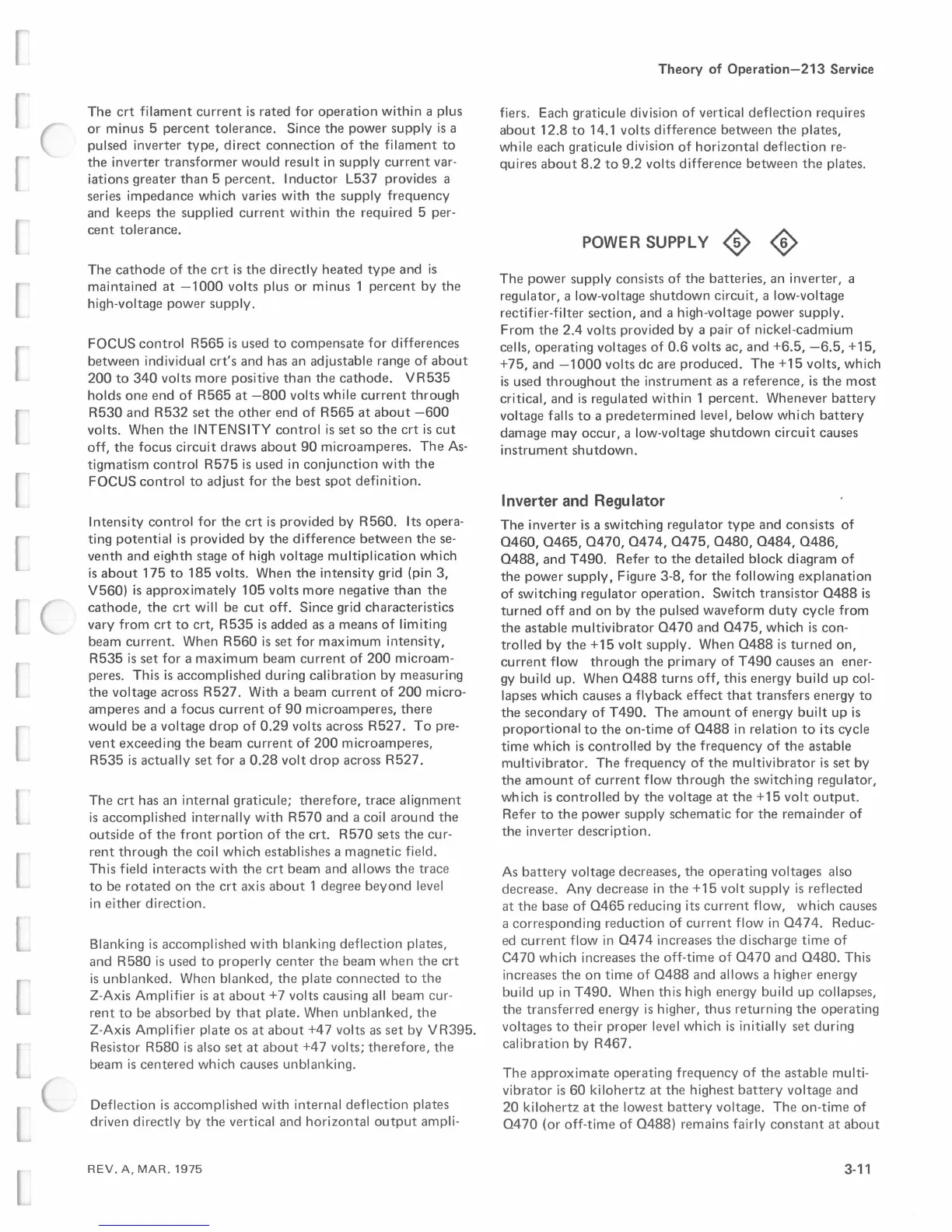The
crt
filament
current
is
rated
for
operation
within
a plus
or
minus
5
percent
tolerance.
Since
the
power
supply
is
a
pulsed
inverter
type,
direct
connection
of
the
filament
to
the
inverter
transformer
would
result
in
supply
current
var-
iations
greater
than
5
percent.
Inductor
L537
provides a
series
impedance
which
varies
with
the
supply
frequency
and
keeps
the
supplied
current
within
the
required
5 per-
cent
tolerance.
The
cathode
of
the
crt
is
the
directly
heated
type
and
is
maintained
at
-1000
volts plus
or
minus
1
percent
by
the
high-voltage
power
supply.
FOCUS
control
R565
is
used
to
compensate
for
differences
between
individual
crt's
and
has an
adjustable
range
of
about
200
to
340
volts
more
positive
than
the
cathode.
VR535
holds
one
end
of
R565
at
-800
volts while
current
through
R530
and
R532
set
the
other
end
of
R565
at
about
-600
volts. When
the
INTENSITY
control
is
set so
the
crt
is
cut
off,
the
focus
circuit
draws
about
90
microamperes.
The
As-
tigmatism
control
R575
is
used
in
conjunction
with
the
FOCUS
control
to
adjust
for
the
best
spot
definition.
Intensity
control
for
the
crt
is
provided
by
R560.
Its opera-
ting
potential
is
provided
by
the
difference
between
these-
venth
and
eighth
stage
of
high voltage
multiplication
which
is
about
175
to
185
volts. When
the
intensity
grid (pin
3,
V560)
is
approximately
105
volts
more
negative
than
the
cathode,
the
crt
will be
cut
off.
Since grid
characteristics
vary
from
crt
to
crt,
R535
is
added
as a
means
of
limiting
beam
current.
When
R560
is
set
for
maximum
intensity,
R535
is
set
for
a
maximum
beam
current
of
200
microam-
peres. This
is
accomplished
during
calibration
by
measuring
the
voltage across
R527.
With a
beam
current
of
200
micro-
amperes
and
a
focus
current
of
90
microamperes,
there
would
be a voltage
drop
of
0.29
volts across
R527.
To
pre-
vent
exceeding
the
beam
current
of
200
microamperes,
R535
is
actually
set
for
a
0.28
volt
drop
across
R527.
The
crt
has an internal graticule;
therefore,
trace
alignment
is
accomplished
internally
with
R570
and
a coil
around
the
outside
of
the
front
portion
of
the
crt.
R570
sets
the
cur-
rent
through
the
coil
which
establishes a
magnetic
field.
This field
interacts
with
the
crt
beam
and allows
the
trace
to
be
rotated
on
the
crt
axis
about
1 degree
beyond
level
in
either
direction.
Blanking
is
accomplished
with
blanking
deflection
plates,
and
R580
is
used
to
properly
center
the
beam
when
the
crt
is
unblanked.
When
blanked,
the
plate
connected
to
the
Z-Axis
Amplifier
is
at
about+
7 volts causing
all
beam cur-
rent
to
be
absorbed
by
that
plate. When
unblanked,
the
Z-Axis
Amplifier
plate
os
at
about
+4 7 volts as
set
by
V
R395.
Resistor
R580
is
also
set
at
about
+4 7 volts;
therefore,
the
beam
is
centered
which
causes
unblanking.
Deflection
is
accomplished
with
internal
deflection
plates
driven
directly
by
the
vertical and
horizontal
output
ampli-
REV.
A,
MAR.
1975
Theory
of
Operation-213
Service
tiers. Each graticule division
of
vertical
deflection
requires
about
12.8
to
14.1 volts
difference
between
the
plates,
while each graticule division
of
horizontal
deflection
re-
quires
about
8.2
to
9.2
volts
difference
between
the
plates.
POWER SUPPLY
~
~
The
power
supply
consists
of
the
batteries,
an
inverter,
a
regulator,
a low-voltage
shutdown
circuit,
a low-voltage
rectifier-filter
section,
and a high-voltage
power
supply.
From
the
2.4
volts provided
by
a pair
of
nickel-cadmium
cells,
operating
voltages
of
0.6
volts ac,
and
+6.5,
-6.5,
+15,
+75,
and
-1000
volts
de
are
produced.
The
+15
volts, which
is
used
throughout
the
instrument
as a
reference,
is
the
most
critical, and
is
regulated
within
1
percent.
Whenever
battery
voltage falls
to
a
predetermined
level,
below
which
battery
damage
may
occur,
a low-voltage
shutdown
circuit
causes
instrument
shutdown.
Inverter and Regulator
The
inverter
is
a switching
regulator
type
and
consists
of
0460, 0465, 0470, 0474, 0475,
0480,
0484,
0486,
0488,
and
T490.
Refer
to
the
detailed
block
diagram
of
the
power
supply,
Figure 3-8,
for
the
following
explanation
of
switching
regulator
operation.
Switch
transistor
0488
is
turned
off
and
on
by
the
pulsed
waveform
duty
cycle
from
the
astable
multivibrator
0470
and
0475,
which
is
con-
trolled
by
the
+15
volt
supply.
When
0488
is
turned
on,
current
flow
through
the
primary
of
T490
causes an ener-
gy build up. When
0488
turns
off,
this
energy
build
up
col-
lapses
which
causes a
flyback
effect
that
transfers
energy
to
the
secondary
of
T490.
The
amount
of
energy
built
up
is
proportional
to
the
on-time
of
0488
in relation
to
its cycle
time
which
is
controlled
by
the
frequency
of
the
astable
multivibrator.
The
frequency
of
the
multivibrator
is
set
by
the
amount
of
current
flow
through
the
switching
regulator,
which
is
controlled
by
the
voltage
at
the
+15
volt
output.
Refer
to
the
power
supply
schematic
for
the
remainder
of
the
inverter
description.
As
battery
voltage decreases,
the
operating
voltages also
decrease.
Any
decrease
in
the
+15
volt
supply
is
reflected
at
the
base
of
0465
reducing its
current
flow,
which
causes
a
cor
r
esponding
reduction
of
current
flow
in
0474.
Reduc-
ed
current
flow
in
0474
increases
the
discharge
time
of
C470
which
increases
the
off-time
of
0470
and
0480.
This
increases
the
on
time
of
0488
and
allows a higher energy
build
up
in
T490.
When
this
high energy build
up
collapses,
the
transferred
energy
is
higher,
thus
returning
the
operating
voltages
to
their
proper
level
which
is
initially
set
during
calibration
by
R467.
The
approximate
operating
frequency
of
the
astable
multi-
vibrator
is
60
kilo
hertz
at
the
highest
battery
voltage and
20
kilohertz
at
the
lowest
battery
voltage.
The
on-time
of
0470
(or
off-time
of
0488)
remains fairly
constant
at
about
3-11

